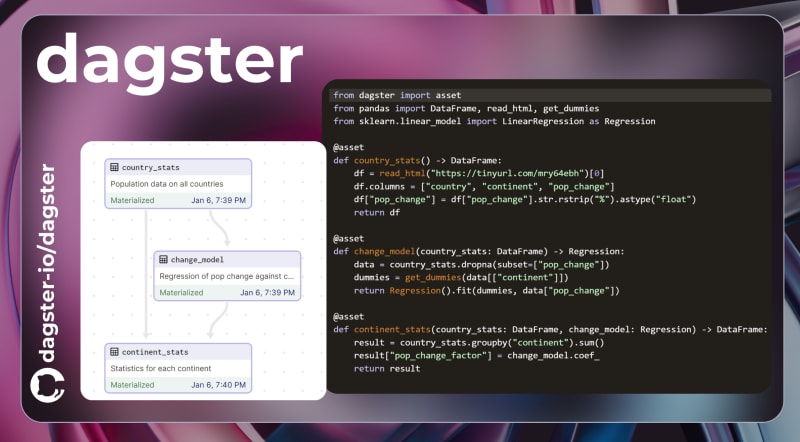

Full-Stack Toolbox 🧰: Python🐍 Edition
source link: https://dev.to/taipy/full-stack-toolbox-python-edition-20h2
Go to the source link to view the article. You can view the picture content, updated content and better typesetting reading experience. If the link is broken, please click the button below to view the snapshot at that time.

TL;DR
Here are Python libraries that focus on different aspects of full-stack development; some focus on web application development, some on the back end, and others on both.

1. Taipy
Taipy is an open-source Python library for building production-ready applications front-end & back-end.
It has been designed to expedite application development, from initial prototypes to production-ready applications.
🔑 Features:
- Extensive interactivity
- There are more customization capabilities for your layout, styling, etc. (no CSS needed)
- Multipage & multi-user applications
- Graphical Pipeline Editor
- Integration with Taipy Front-end capabilities for an end-to-end deployment
- Scheduling
- Notebook compatible

Your support means a lot🌱, and really helps us in so many ways, like writing articles! 🙏
2.Prefect
Prefect is a framework offering data pipeline development.
It sets itself apart from competitors like Airflow by focusing on simplicity and user-friendliness.
Prefect is a good in-between if you want a mature product with various features but an easier learning curve than Airflow.
🔑 Features:
- Intuitive and user-friendly control panel
- intelligent features such as caching
- Flow-based structure to ease into workflow organization
- Dynamic parametrization & dependency management
- Hybrid execution ( Local/Cloud)
3. Streamlit
Streamlit is a game changer for quickly and simply building web applications.
This data app framework focused their differentiation from more complete and complex solutions to a quick and user-friendly solution.
🔑 Features:
- Pythonic framework
- Interactive widgets
- User-friendliness
4.Airflow
Apache Airflow is an open-source platform designed for scheduling and monitoring workflows.
It's an excellent choice for orchestrating complex data pipelines and ETL processes, as it has been a prominent player in the pipeline landscape for the last decade.
The completeness of this library is associated with a steep learning curve.
🔑 Features:
- DAG-Based Workflow Definition
- The complete interface that includes visualization of DAGs tracks failures and manages retries.
- Various integration
- Dynamic Task Execution and Scheduling
- Python-Centric Design
- Community Support
5. Brython
Brython brings Python to the front-end, as the name regroups “Browser” and “Python”.
It introduces a unique concept of running Python code directly in web applications.
This innovative approach allows you to build interactive web experiences using Python.
🔑 Features:
- Easy integration as it integrates the Python logic directly into the browser
- Compatible with different web browsers
6. Dash
Dash, created by Plotly, is a web application framework using the completeness of Plotlys’ components.
It is known to be a complete solution, and with that comes a longer time to master.
🔑 Features:
- Component-based architecture
- Powerful interactive dashboards
- Real-time data updates
7. Dagster
Dagster, one of the newer libraries in this compilation, is a cloud-native data pipeline orchestration aiming to unify data integration, workflow orchestration, and monitoring.
Compared to other tools, Dagster emphasizes the DataOps aspect of the workflow creation and management.
🔑 Features:
- Declarative pipeline setup
- Opinionated structure
- Versioning
- Integration with Hadoop
- Comprehensive metadata tracking
8. SQLAlchemy
SQLAlchemy is a Python library used to handle database interaction.
It is a versatile toolkit that links Python programming and relational databases.
The time to master this library is longer, but the benefits are real.
🔑 Features:
- SQL Expression language
- Object-Relation Mapping (ORM)
- Wide support for databases
- Complex query support
9. Celery
Celery is a Python library used as a framework to build back-end applications.
It handles distributed task processing, job executions, and workflows.
It is a complete solution and extensive feature set with a steeper learning curve.
🔑 Features:
- Parallel processing
- Scalability
- Task scheduling
- Asynchronous processing
10. Peewee
Like SQAlchemy, Peewee is a Python library that simplifies database interaction.
It differs from its competitors with a user-friendly and simple setup.
This library is the best option for small to medium projects.
🔑 Features:
- Lightweight framework
- Database support
- Pythonic syntax
11. Kedro
Kedro is an open-source Python framework.
It provides a toolbox for production-ready data science pipelines.
Indeed, Kedro easily integrates with well-established Python ML libraries and provides a unified way to implement an end-to-end framework.
🔑 Features:
- Data Catalog
- Notebooks integration
- Project template
- Opinionated as it enforces specific conventions
Conclusion
Python is considered the go-to language for AI and Machine learning applications.
To streamline and automate these applications, Python has been witnessing the emergence of framework libraries.
These libraries facilitate web application development, back-end services, and the creation of open-source full-stack applications.

I just started my content creation journey; feel free to reach out if you have any questions or feedback!
Recommend
About Joyk
Aggregate valuable and interesting links.
Joyk means Joy of geeK










